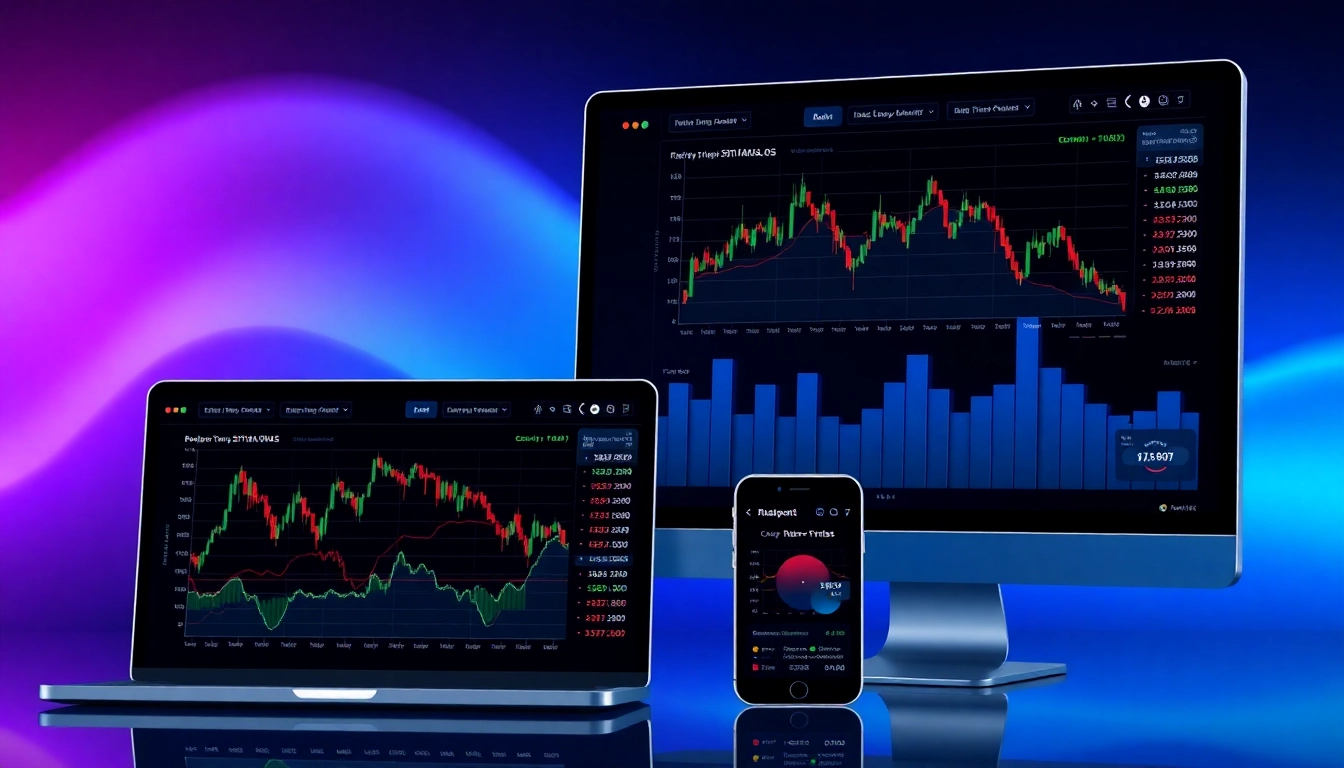Enhancing Trading and Investment Reporting in a Dynamic Market Environment
In today’s fast-paced financial landscape, effective trading and investment reporting serve as the backbone of informed decision-making. As markets continually fluctuate—evidenced by recent mixed stock performances, record-breaking gold prices, and shifts in global currencies—having precise, timely, and comprehensive market data is paramount. For investors and traders seeking to stay ahead, understanding how to optimize reporting processes—leveraging the latest technological advancements and adhering to best practices—is crucial. This article delves into the core components of reliable market data collection, explores innovative solutions such as AI-driven analytics, and offers strategic insights for maintaining a competitive edge in today’s volatile environment.
Understanding the Foundations of Trading and Investment Reporting
Key Components of Effective Market Data Collection
At the heart of robust trading and investment reporting lies comprehensive data collection. This involves aggregating diverse data points—from traditional financial metrics like earnings, revenue, and balance sheets to real-time market indicators such as stock prices, commodity prices, currency exchange rates, and geopolitical developments. Advanced data collection tools integrate sources like Bloomberg Terminal, Reuters, and various API feeds to ensure completeness. The goal is to create a single, trusted dataset that accurately reflects the current market landscape.
Effective data collection also requires meticulous validation procedures to identify anomalies or discrepancies. For example, during recent market events, such as the surge in gold prices to over $3,500 per ounce, analysts relied on high-frequency data from multiple sources to confirm authenticity and determine the precise timing of price movements, enabling traders to respond swiftly and accurately.
The Role of Accurate Financial Reporting in Trading Decisions
Accurate financial reporting transforms raw data into actionable insights. It involves synthesizing information into clear, consistent reports—ranging from daily dashboards to quarterly earnings summaries—that inform traders’ strategies. Precision here helps prevent misinterpretations that could lead to costly mistakes, especially when market volatility spikes, like during the recent U.S. labor data releases or geopolitical tensions affecting oil prices.
Reliable reporting fosters transparency and confidence among market participants, ensuring that trading decisions are rooted in factual, timely data. For instance, Meta’s exploration of partnerships to enhance app functionality demonstrates how accurate data about user engagement and app performance feeds into strategic choices that can directly impact trading related to technology firms.
Common Challenges in Trading and Investment Reporting
Despite its importance, several obstacles can hinder effective reporting. These include data silos, inconsistent data formats, latency issues, and regulatory compliance complexity. A notable challenge is ensuring data integrity amid rapid market fluctuations, such as the recent drop in cryptocurrencies like Bitcoin and Ether, where delays or inaccuracies in data feeds could lead investors astray.
Another issue revolves around compliance; regulatory frameworks require precise, transparent reporting that can be scrutinized by authorities. As markets evolve—highlighted by developments like the UK’s strict conditions for Facebook’s Libra cryptocurrency release—adapting reporting practices to meet diverse regulations is crucial for maintaining trust and avoiding penalties.
Implementing Best Practices for Reliable Market Analysis
Utilizing Real-Time Data for Prompt Decision-Making
The ability to act swiftly hinges on accessing real-time market data. Traders leverage streaming feeds for commodities, currencies, and equities to capitalize on transient opportunities. For example, following remarks by U.S. advisers about the dollar’s movements or geopolitical developments, real-time analytics can help traders adjust strategies immediately, preserving profitability amid volatile conditions.
Integrating platforms that provide live updates on indices like the pan-European STOXX 600 or major currency pairs (e.g., USD/JPY) enables traders to execute timely orders, avoid slippage, and optimize entry and exit points, especially in turbulent times like during U.S.-China trade conflicts or FED rate speculation.
Integrating Automated Tools and Analytics
Automation through sophisticated analytics tools enhances the accuracy, speed, and consistency of reporting. Machine learning models can identify patterns and forecast market trends with higher precision than manual analysis. For instance, predictive analytics are increasingly used to anticipate Bitcoin’s path if its 200-week trendline remains intact, as well as to evaluate the impact of macroeconomic indicators like U.S. inflation data or European Union economic reports.
Automated dashboards synthesize multiple data sources, alert traders to anomalies—such as a sudden spike in oil prices after US policy commentary—and recommend action steps, thereby reducing human error and reaction time.
Ensuring Data Integrity and Compliance
Maintaining data integrity is non-negotiable for trustworthy reporting. Implementing validation protocols, version control, and encryption helps safeguard data against corruption and unauthorized access. Simultaneously, compliance requirements demand rigorous documentation and audit trails—especially pertinent when reporting to regulators like the SEC or FCA.
Organizations must adopt standards that guarantee data quality and ensure that all reports adhere to regulatory frameworks, avoiding penalties or reputational damage. Case studies of recent market responses—like the aggressive sell-offs in NFT markets or gold surges—highlight how precise reporting and compliance can significantly influence investor confidence.
Leveraging Technology to Enhance Trading and Investment Reporting
AI and Machine Learning Applications in Market Reporting
Artificial Intelligence (AI) is revolutionizing market reporting by enabling predictive analytics, sentiment analysis, and anomaly detection. For example, AI algorithms can analyze news sentiment and social media trends—such as meta-analyses suggesting Meta’s app partnerships—to forecast impacts on tech stocks.
Machine learning models also adapt over time, improving forecast accuracy for assets like cryptocurrencies, where market data is highly volatile. During recent fluctuations, AI-driven models could anticipate potential bull runs if macro trendlines, such as Bitcoin’s 200-week trendline, remain supportive. These applications empower traders with forward-looking insights, not just historical data.
Choosing the Right Software Solutions
Investing in scalable, user-friendly, and compliant software solutions is critical. Platforms like Bloomberg Terminal, Thomson Reuters Eikon, and emerging AI-powered analytics tools offer customizable dashboards, robust data security, and compliance features. When selecting tools, traders should consider integration capabilities, real-time processing capacity, and analytical depth.
Case in point: leading firms are now integrating external AI models into their internal tools to optimize trading workflows, reduce human error, and enhance decision-making accuracy—demonstrating the importance of technological adaptability.
Future Trends in Financial Data Tech
Looking ahead, trends such as decentralized finance (DeFi), increased use of blockchain for data transparency, and quantum computing promise to further transform reporting. These innovations aim to enhance speed, security, and accuracy—key factors in maintaining a competitive edge in global markets.
Additionally, data virtualization techniques and heightened focus on ESG (Environmental, Social, and Governance) reporting are shaping future frameworks, requiring traders to adapt their data collection and analysis strategies accordingly.
Analyzing Market Trends with Confidence
Case Studies of Successful Trading Reports
One illustrative example is the recent surge in gold prices, hitting a record of over $3,500 per ounce amid US inflation worries and geopolitical uncertainties. Traders who utilized comprehensive reporting and real-time analytics could swiftly interpret macro signals, confirming the upward trend and executing strategic buy orders.
Similarly, during the recent crypto market slowdown, entities leveraging advanced predictive models and detailed reports managed to mitigate losses and reposition assets more effectively than competitors relying solely on manual analysis.
Performance Metrics to Track Reporting Effectiveness
To gauge the success of reporting processes, traders should track metrics such as data accuracy rates, timeliness of reports, decision-to-result lag, and compliance audit outcomes. Continuous monitoring ensures reports remain aligned with market realities and regulatory requirements.
For example, a quick identification of discrepancies in oil price data during recent declines allowed traders to adapt positions swiftly, highlighting the importance of these metrics.
Adapting Reports for Market Volatility
In unpredictable markets, flexibility is vital. Reports should incorporate scenario analysis and stress testing to prepare traders for sudden shocks—like sudden currency drops or commodity price swings. Dynamic dashboards that update continuously and include multiple alert levels support proactive strategy adjustments.
For instance, during the escalation of geopolitical tensions impacting Russian crude imports, traders who relied on adaptable reports could limit exposure and hedge positions effectively.
Advanced Strategies for a Competitive Edge in Investment Reporting
Data-Driven Investment Portfolio Optimization
Portfolio managers now employ data analytics to optimize asset allocations. By analyzing historical return patterns, volatility measures, and correlation matrices, they construct resilient portfolios suited to prevailing market conditions. The recent rise of metals like gold suggests an increased allocation to safe-haven assets in uncertain times.
Tools such as Monte Carlo simulations and backtesting models help evaluate potential outcomes, guiding more informed deployment of capital.
Predictive Analytics for Market Forecasting
Forecasting future market movements involves integrating macroeconomic indicators, technical trends, and sentiment data. For example, recent US labor data releases, along with Fed rate cut expectations, can be fed into predictive models to anticipate currency movements and equity index shifts. These insights support proactive trading strategies, reducing reaction delays and capturing emerging opportunities.
Regulatory Considerations in Reporting Accuracy
Maintaining compliance extends beyond data accuracy; it involves aligning with evolving regulatory standards. Transparency, auditability, and data security are fundamental. Organizations must routinely review their reporting frameworks, incorporating updates from agencies like the FCA or SEC to avoid penalties and safeguard reputations.
Proactive compliance not only avoids sanctions but enhances credibility, especially in sensitive markets such as cryptocurrencies and NFTs, where recent market cap drops and valuations reflect the importance of diligent reporting.



